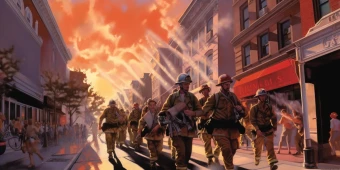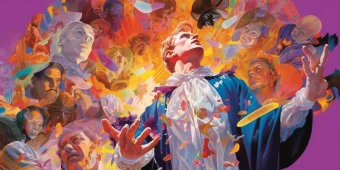by Flannery O'Connor


A Good Man is Hard to Find Literary Analysis
Table of contents
- Symbolism
- Setting
- Point of View
- Tone&Mood
- The Misfit
- The Grandmother's hat
- The car
- The woods
- The grandmother's cat
- The gun
Symbolism
Flannery O'Connor's "A Good Man Is Hard to Find" is a richly symbolic story that utilizes a variety of literary devices to convey its themes. The story is packed with symbolism that is both obvious and subtle, contributing to the deeper meaning of the narrative. Here are some of the main symbols in “A Good Man Is Hard to Find” and their meanings in the story.
The Misfit
The Misfit is the central symbol in the story. He represents the embodiment of evil and violence in the story. He is a symbol of the harsh realities of life that the grandmother and her family encounter on their trip. His name alone implies that he is not a typical or ordinary criminal but someone who is out of place in society. The Misfit's mannerisms and speech are also symbolic of his character. He speaks in a calm and collected manner, yet he is capable of committing heinous acts of violence. He shows no remorse for his actions, and his words suggest that he is more aware of his true nature than the grandmother and her family are. His ability to manipulate and control the situation further emphasizes his power and the danger he poses. The Misfit's character is a stark contrast to the grandmother's idealistic views of the world, and his presence serves to expose the harsh realities of life that she has tried to avoid.
The Grandmother's hat
The Grandmother's hat is a symbol of her desire for social status and her old-fashioned values. The hat is described as a "navy blue straw sailor hat with a bunch of white violets on the brim" and is worn by the Grandmother to give her a sense of dignity and respectability. She believes that her appearance is important, and that by dressing well she can exert a measure of control over her surroundings.
The hat also serves as a symbol of the Grandmother's old-fashioned values. It is part of her attempt to maintain a sense of propriety and decorum in a world that she perceives as becoming increasingly chaotic and immoral. She believes that her hat and other accessories set her apart as a lady of refinement and culture, and that they are a reminder of a time when manners and morals were held in higher regard.
In "A Good Man Is Hard to Find", symbolism of hat takes on an additional layer of meaning when the Grandmother loses it during the car accident. This loss symbolizes the loss of the Grandmother's sense of control and her eventual realization that her values and beliefs are not as fixed and certain as she had once believed. It is a moment of crisis for the Grandmother, and her loss of the hat is symbolic of her loss of control over the situation.
The car
The car symbolizes the family's journey towards their inevitable demise. The car is repeatedly referred to as "climbing" and "rattling," suggesting that the family is slowly ascending towards their tragic end. The car also represents the family's desire for independence and freedom, but this desire ultimately leads them to their downfall. The car is also associated with the Misfit and his henchmen, who use it as a tool of destruction and violence.
The car is initially seen as a source of excitement and adventure for the family, but it becomes a vehicle for their destruction. The car is also symbolic of the changing times and values of the South, as the family's old-fashioned attitudes and beliefs clash with the modern world represented by the car. In this way, the car serves as a metaphor for the family's inability to adapt to the changing world around them, ultimately leading to their tragic end.
The woods
The woods serve as a symbol of the unknown and the dangerous. When the family takes a detour onto a dirt road that leads them into the woods, the reader knows that something bad is going to happen. The woods are described as "dark and deep" and "lovely" but also "sinister." The trees and bushes are so thick that the sun cannot penetrate them, which adds to the feeling of being lost and trapped.
As the family ventures further into the woods, they become more vulnerable to the dangers that lurk there. The Misfit and his accomplices are able to trap them in the woods, away from the eyes of society and the protection of civilization. The woods also serve as a metaphor for the family's descent into chaos and darkness. The order and safety of the road is left behind as they venture deeper into the woods, just as the family's orderly and predictable life is shattered by the events of the story.
In the end, the woods serve as the setting for the final confrontation between the Misfit and the Grandmother. It is here that the Grandmother realizes the depth of her own depravity and the true nature of evil.
The grandmother's cat
The grandmother's cat is a minor but significant symbol that highlights the theme of innocence and vulnerability in the story. The cat is portrayed as a harmless creature that the grandmother insists on bringing along for the car trip. She believes that the cat would not survive on its own and wants to take it with them to their destination. However, the cat's fate is left unknown after the family's car crashes and they come across the Misfit and his accomplices.
The cat serves as a metaphor for the innocent and helpless individuals who become casualties of violence and evil. The grandmother is also an example of this, as her manipulation and selfishness ultimately lead to the family's encounter with the Misfit. Like the cat, the grandmother is vulnerable to the dangers of the world and is unable to protect herself or those around her. The cat's disappearance adds to the uncertainty and sense of foreboding in the story, as it leaves the reader wondering about its fate and the fate of the family. The cat's symbolic representation emphasizes the message that the innocent and vulnerable are often the ones who suffer in a world that is unpredictable and full of danger.
The gun
The gun is a powerful symbol of violence and death. The Misfit and his gang carry guns and use them to kill the family. The gun is a physical representation of the Misfit's power and control over life and death. It is also a symbol of the violent, unpredictable world in which the characters live.
The grandmother's recognition of the Misfit's gun is significant because it reveals her awareness of the danger they are in. She realizes that the Misfit is not a good man and that he is capable of using the gun to harm them. However, her realization comes too late, and her attempts to appeal to the Misfit's humanity are futile. The gun ultimately represents the inevitability of the family's tragic fate, as well as the brutal reality of the world in which they live.
In conclusion, Flannery O'Connor's use of symbolism in "A Good Man Is Hard to Find" enhances the depth and complexity of the story's themes. The symbols in the story are carefully chosen and contribute to the overall meaning of the narrative. The story uses symbols to explore the themes of good and evil, family, and redemption, and to create a richly layered and thought-provoking narrative.
Setting
Flannery O’Connor’s short story “A Good Man Is Hard to Find” is renowned for its vivid and impactful descriptions of the setting. The story takes place in the rural south of the United States, in the 1950s. In “A Good Man Is Hard to Find”, the setting, which is largely symbolic, serves to create a sense of foreboding and tension that ultimately leads to the tragic climax of the story.
The story begins with a description of the family’s trip from their home in Georgia to Florida. The first setting is the family’s home, which is described as a typical southern dwelling with a yard of “red gravel.” The family then sets out on their road trip, passing through various rural areas that are described in detail. These descriptions include abandoned cotton fields, rundown gas stations, and small towns. The family stops for lunch at a diner that is described as being “a long dark room with a counter at one end and tables at the other and dancing space in the middle.” The descriptions of the various settings, including the diner, serve to create a sense of discomfort and unease that is felt throughout the story.
The main setting in “A Good Man Is Hard to Find” is the secluded back road where the family’s car crashes and they encounter the Misfit and his gang. The road is described as “a narrow dirt road through the woods,” which serves to create a sense of isolation and danger. The family’s car is also described in detail, and its breakdown serves as a symbol of their vulnerability and helplessness.
The final setting of the story is the woods, where the Misfit and his gang murder the family. The woods are described as “dark and deep,” with “yellow slashes” of sunlight shining through the trees. This setting serves to create a sense of darkness and death, and it is where the family ultimately meets their tragic end. The description of the “yellow slashes” of sunlight can also be seen as a symbol of hope, or a glimmer of the divine in the midst of darkness.
Overall, the setting in “A Good Man Is Hard to Find” plays a significant role in creating a sense of tension and unease throughout the story. The various settings serve to create a sense of isolation and danger, and the final setting in the woods is where the tragic climax of the story takes place. The vivid and symbolic descriptions of the setting serve to reinforce the themes of the story, including the themes of goodness and evil, redemption, and the power of the divine in the midst of darkness.
Point of View
In "A Good Man is Hard to Find," Flannery O'Connor uses a third-person limited point of view to tell the story. This means that the narrator only knows the thoughts and feelings of one character, usually the protagonist or a main character, and reports events from their perspective. In this case, the narrator is not a character in the story but instead follows the grandmother's point of view.
The third-person limited point of view is particularly effective in this story because it allows the reader to closely follow the grandmother's thoughts and emotions. Throughout the story, the reader is given access to the grandmother's inner monologue, which reveals her true motivations and desires. The reader is able to understand her fear of change and her desperate need to be seen as a lady. This understanding makes the story's shocking ending all the more powerful, as the reader is able to see the grandmother's desperation for herself.
O'Connor's use of the third-person limited point of view also allows her to control the flow of information in the story. As the story progresses, the reader is given more and more insight into the grandmother's thoughts and motivations, which builds suspense and tension. For example, early in the story, the grandmother is shown to be a nagging and somewhat annoying character, but as the story progresses, the reader begins to sympathize with her fear and vulnerability.
Another important aspect of the point of view is how it affects the reader's perception of the other characters in the story. Because the narrator only reports events from the grandmother's perspective, the other characters are often presented in a negative light. For example, the children are portrayed as bratty and disrespectful, and Bailey is shown to be impatient and dismissive of the grandmother's concerns. The Misfit, too, is initially presented as a cold and ruthless killer. However, the limited point of view allows for some ambiguity in the characterizations, and the reader is left to decide whether the other characters are truly as bad as the grandmother perceives them to be.
Overall, the third-person point of view in "A Good Man is Hard to Find" allows for a deep exploration of the grandmother's character and motivations, while also creating suspense and tension for the reader. It is an effective tool in O'Connor's masterful storytelling, leaving a lasting impact on the reader long after the story has ended.
Tone&Mood
In "A Good Man is Hard to Find", the tone and mood of "A Good Man is Hard to Find" are complex and multi-layered, reflecting the various themes and ideas explored in the story.
One of the most dominant tones in the story is one of irony. From the beginning, the Grandmother is portrayed as a pious, church-going woman who believes in the power of goodness and the importance of being a "lady." However, her actions and words reveal a hypocritical nature that contrasts sharply with her professed values. This irony is also reflected in the Misfit, who claims to be a "good man," yet is a cold-blooded killer. The irony in the story highlights the hypocrisy and moral ambiguity of the characters and the world they inhabit.
Another dominant tone in the story is one of suspense and foreboding. From the moment the family sets out on their trip, there is a sense of unease and impending danger. The foreshadowing of the accident and the description of the Misfit's escape from prison create a palpable sense of tension and fear. This tone is heightened by the vivid and graphic violence that occurs in the final scene, leaving the reader with a sense of shock and horror.
The mood of the story is similarly complex, reflecting the different emotions and responses elicited by the various themes and tones. There is a sense of melancholy and nostalgia in the opening scene, as the Grandmother reflects on the past and longs for a simpler time. This mood is quickly replaced by one of humor and satire as the family dynamic is revealed, particularly in the interactions between the Grandmother and her son, Bailey.
As the story progresses, the mood becomes more ominous and dark, as the family becomes increasingly lost and disoriented. The sense of dread is heightened by the description of the deserted back roads and the dilapidated gas station where the family stops. The mood is also influenced by the bleak and oppressive nature of the landscape, which reflects the moral decay and corruption of the characters.
In the final scene, the mood shifts once again to one of shock and horror, as the Misfit and his accomplices murder the entire family. The graphic violence and the description of the family's final moments create a mood of tragedy and despair, leaving the reader with a sense of sadness and loss.
Overall, the mood and tone of "A Good Man is Hard to Find" are complex and multi-layered, reflecting the different themes and ideas explored in the story. The irony, suspense, and foreboding create a sense of tension and unease, while the humor and nostalgia provide moments of levity and reflection. The final scene, with its graphic violence and tragic ending, creates a mood of horror and despair, leaving the reader with a sense of the darkness and moral ambiguity of the world depicted in the story.

- Instructions Followed To The Letter
- Deadlines Met At Every Stage
- Unique And Plagiarism Free


 The Things They Carried
The Things They Carried
 The Yellow Wallpaper
The Yellow Wallpaper
 Hamlet
Hamlet